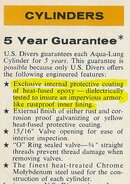halocline
Contributor
It can not pass VIP according to DOT regs because you can not inspect for damage under the lining.
See how easy it is for mis-information to get perpetuated? In your defense, there are undoubtedly many hydrotesters at licensed test shops that think the same thing. Probably an accurate statement would be "It will be more difficult to get a lined tank inspected and filled at a dive shop because so many shops think that the lining means VIP failure"
Regarding these particular tanks, the inside looks great to me, I didn't see any evidence of a lining, and I'm not sure why you tumbled for so long, but you sure got 'em clean.




